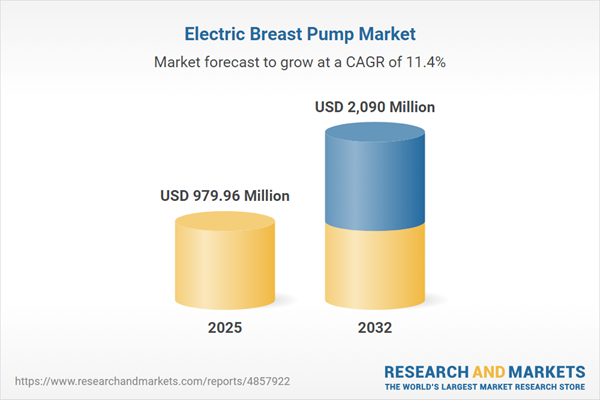Speak directly to the analyst to clarify any post sales queries you may have.
The electric breast pump market is experiencing significant transformation driven by rapid healthcare technology innovation and shifting maternal care priorities. Senior decision-makers are aligning with evolving user expectations, operational efficiencies, and paths to clinical leadership, capitalizing on opportunities in a dynamic global environment.
Market Snapshot: Electric Breast Pump Market Size, Growth, and Forecast
The global electric breast pump market was valued at USD 880.07 million in 2024 and is expected to expand to USD 979.96 million in 2025, eventually reaching USD 2.09 billion by 2032. This projected growth represents a CAGR of 11.43%.
Increased adoption of technologically advanced breast pumps is enabling measurable improvements in maternal health outcomes, prompting an upsurge in investment by both institutional and consumer-focused healthcare providers. Enhanced care delivery models, efficiency gains, and emphasis on user experience are reinforcing the leadership of established players while influencing procurement and access strategies globally.Scope & Segmentation: Electric Breast Pump Market
Robust segmentation is essential for executive teams seeking to align organizational strategy with a rapidly changing technology landscape. The electric breast pump market is characterized by critical drivers such as ongoing innovation, adaptive regional approaches, and resilient supply networks. Understanding the following segments supports targeted growth and procurement strategies:
- Pump Types: Single and double electric breast pumps cater to both high-demand clinical environments and individualized at-home use, offering various performance profiles to meet differing user and institutional requirements.
- Mechanisms: Closed-system breast pumps prioritize minimizing contamination and supporting clinical-grade hygiene, while open-system devices are chosen for simplified cleaning and suitability in home care applications.
- Distribution Channels: Broad access is achieved via hospitals, pharmacies, specialty medical suppliers, and expanding e-commerce, supporting diverse procurement models and responsiveness to varied buyer needs.
- Power Sources: Both AC-powered models optimized for constant institutional use and battery-operated, rechargeable pumps that prioritize mobility support usage across inpatient, outpatient, and remote care settings.
- End Users: Hospitals, maternal health centers, and individual users seek electric breast pumps for workflow integration, discrete operation, and to optimize care processes for both caregivers and patients.
- Regional Coverage: Growth momentum extends across the Americas, EMEA, and Asia-Pacific, with notable market activity in China, India, Japan, and Australia due to regulatory modernization and infrastructure advances.
- Company Developments: Leading manufacturers such as Medela AG, Royal Philips N.V., Spectra Baby USA, and Ardo Medical AG focus on elevating product standards, rapidly advancing development, and addressing evolving patient and provider needs.
Key Takeaways for Decision Makers
- Digital health technology is reshaping maternal care delivery, enabling remote monitoring and enhancing engagement for improved management and satisfaction among patients and clinicians.
- Connectivity advancements foster integration of devices into hospital IT systems and home environments, boosting workflow efficiency and simplifying device management.
- User-focused improvements such as simplified operation, device interoperability, and intuitive interfaces are prioritized to streamline usage and support staff productivity.
- Regional expansion requires bespoke approaches; tailoring strategies for local regulatory compliance, demographic needs, and reimbursement structures helps ensure sustainable market entry and operational continuity.
- Sustainable materials use and proactive supply chain resilience are supporting procurement functions in meeting environmental requirements and aligning with industry benchmarks.
- Partnerships with diverse suppliers and growth in local manufacturing operations help maintain reliable supply and protect against market or logistical interruptions.
Tariff Impact: Navigating U.S. Trade Policy Shifts
Continued fluctuations in U.S. trade policy, including the impact of potential tariffs, prompt manufacturers and distributors to diversify sourcing and enhance supply chain cooperation. By investing in domestic operations and collaborating with regional suppliers, organizations can mitigate disruption risks, maintain vital inventory levels, and adjust effectively to regulatory or policy change.
Methodology & Data Sources
This analysis draws from direct interviews with product developers, procurement professionals, and clinical users in the electric breast pump market. Validation is ensured through regulatory filings, peer-reviewed publications, and financial records from principal industry participants, delivering actionable insights for executive planning and procurement teams.
Electric Breast Pump Market: Why This Report Matters
- Supplies actionable intelligence to refine development and direct market expansion initiatives across the maternal healthcare technology sector.
- Enables leadership to pinpoint innovation opportunities, drive cross-functional collaboration, and cultivate flexible growth in established and emerging markets.
- Supports operations and procurement teams to anticipate potential risks and proactively adapt to changes in regulatory, policy, and supply chain dynamics.
Conclusion
Strategic, well-informed market analysis gives executive teams the tools needed to strengthen business resilience, guide effective procurement, and sustain competitiveness within a technology-driven maternal health landscape.
Additional Product Information:
- Purchase of this report includes 1 year online access with quarterly updates.
- This report can be updated on request. Please contact our Customer Experience team using the Ask a Question widget on our website.
Table of Contents
3. Executive Summary
4. Market Overview
7. Cumulative Impact of Artificial Intelligence 2025
Companies Mentioned
The companies profiled in this Electric Breast Pump market report include:- Medela AG
- Royal Philips N.V.
- Spectra Baby USA Co., Ltd.
- Ardo Medical AG
- Ameda, Inc.
- Lansinoh Laboratories, Inc.
- Artsana S.p.A.
- Mayborn Group Limited
- Kiinde, Inc.
- Evenflo Company, Inc.
Table Information
| Report Attribute | Details |
|---|---|
| No. of Pages | 182 |
| Published | October 2025 |
| Forecast Period | 2025 - 2032 |
| Estimated Market Value ( USD | $ 979.96 Million |
| Forecasted Market Value ( USD | $ 2090 Million |
| Compound Annual Growth Rate | 11.4% |
| Regions Covered | Global |
| No. of Companies Mentioned | 11 |









